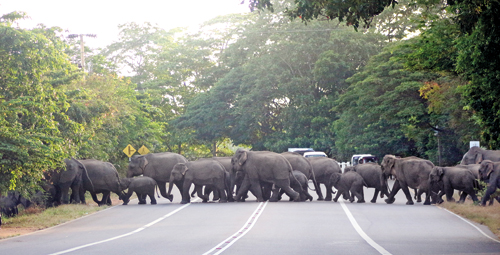A feast awaits them at the end of this crossing

Endearing sight to behold: Traffic comes to a halt to make way for the jumbos. Pix by R.M.J. Bandara
Majestic and dignified, they crossed the main road, as ooh and aahs of “thava enawa” greeted them, unperturbed by a few humans even revving motorcycle engines to taunt them.
Some, however, were not so dignified – the babies naughtily gambolling across, while a tall and handsome tusker halted awhile to cast his eyes this way and that and a few getayas stopped short once on the other side of the road as if throwing a challenge to any human who dared to impede their journey.
Not one or two but more than 100 elephants crossing the road – a heartwarming scene which has gone viral amidst a society caught in the grip of disease and death brought about by COVID-19.
“A large herd of mostly female elephants and their babies do this crossing regularly to feast on the leftover harvests (ipanelle) in the paddy fields across the road,” says the Chairman of the Centre for Conservation and Research (CCR), Dr. Prithiviraj Fernando who studies elephants at close quarters.
The crossing takes place quite close to the Galgamuwa town on the Padeniya-Anuradhapura Road.

Keeping the small one in check
Explaining that there is a Forest Department plantation on one side of the road where the herd spends the day, Dr. Fernando who does much research in the Galgamuwa area says that they cross over to the other side in the night, where spreads the harvested paddy fields to take their fill.
In the night, the elephants push down the electric fence which limits them to the Forest Department plantation, away from the fields fed by the tanks of the Mee Oya basin in the northwestern dry zone. Then they break it again in the morning to get back to the Forest Department area.
The Department of Wildlife Conservation (DWC) keeps repairing the electric fence and the elephants persist in pushing it down on a daily basis, it is learnt. To and fro, from the Forest Department area to the fields and back, in addition to breaking the fence the elephants have to cross the main road and the railtrack.
Urgent need for elephant corridors
To bring some resolution to this situation, two elephant corridors have been proposed under the North Western Province Canal Project (NWCP) based on radio tracking data of elephants collared by the DWC and the CCR. But these corridors have not seen the light of day.

Taking his own cool time: The handsome Tusker
The NWCP will divert Moragahakanda waters to the northern part of the North Western Province and feed the upper Mee-Oya catchment. It is part of the Mahaweli Water Security Investment Programme funded by the Asian Development Bank and implemented by the Mahaweli Development and Environment Ministry.
Dr. Fernando says that the two proposed elephant corridors – one a permanent corridor across a few paddy fields to the Maha-Galgamuwa tank and a seasonal corridor under the existing road and railway bridges to access the harvested paddy fields – under the NWCP Wildlife Management Plan developed about four years ago, have not been established yet.
All stakeholders including the Divisional Secretariat and farmer societies had agreed to these corridors, it is understood.
“These corridors are a small but ‘critical’ step to safeguard and protect both the farmers and the wild elephants. They will limit the increase in the human-elephant conflict (HEC) that will result from implementing the NWCP,” adds Dr. Fernando.


